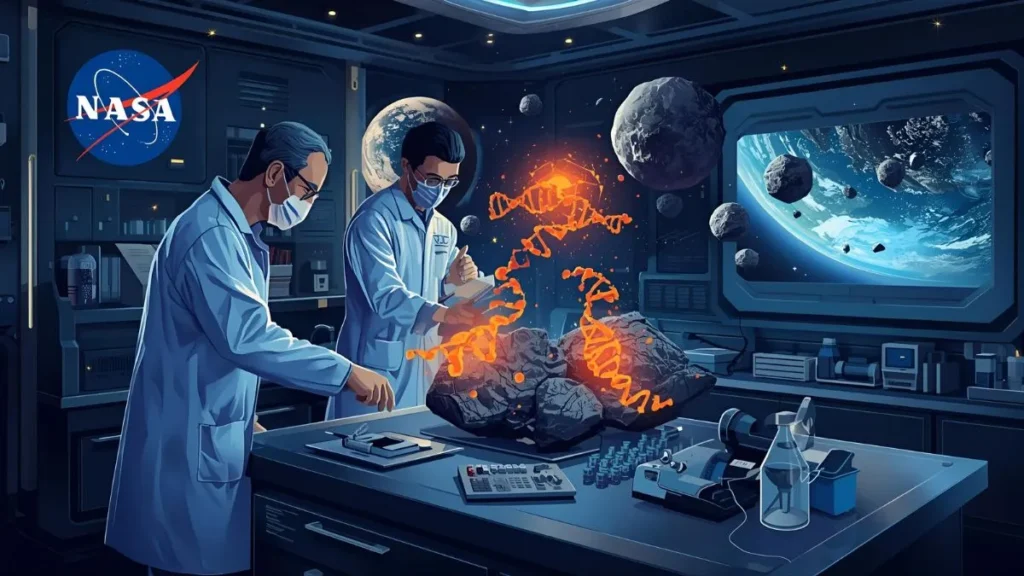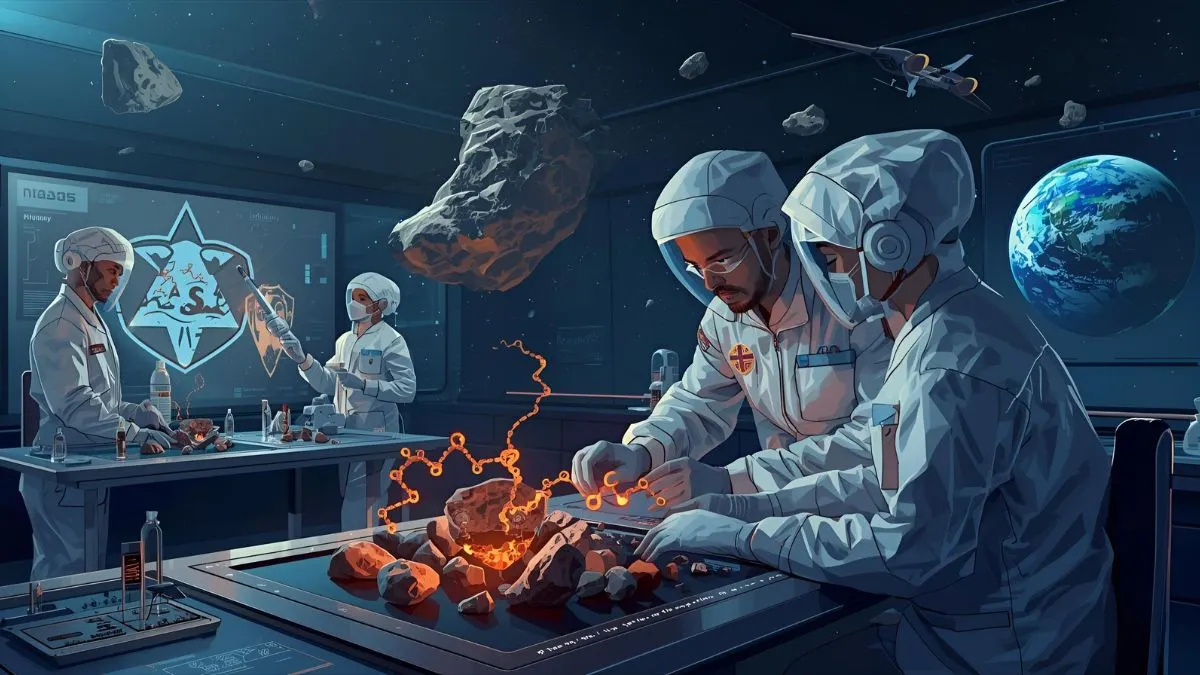NASA Asteroid: NASA’s ongoing asteroid research has achieved groundbreaking discoveries in September 2025, with analysis of samples from asteroid Bennu revealing all five DNA and RNA building blocks while the agency continues monitoring potentially hazardous near-Earth objects. These developments underscore the critical importance of asteroid science both for understanding life’s origins and protecting Earth from cosmic threats.
Bennu Samples Unlock Secrets of Life’s Origins
The most significant development in NASA’s asteroid research involves detailed analysis of samples returned from asteroid Bennu by the OSIRIS-REx mission in September 2023. Recent studies published in Nature Astronomy reveal that Bennu contains all five nucleobases that encode genetic information in DNA and RNA, along with 14 of the 20 amino acids that life uses to create proteins.
Key Scientific Discoveries: NASA Asteroid
Complete genetic toolkit: Scientists have identified adenine, guanine, cytosine, thymine, and uracil in the pristine Bennu samples—the first time all five nucleobases have been found together in an asteroid sample. This discovery supports the theory that asteroids delivered life’s essential ingredients to early Earth.
Amino acid diversity: The samples contain a remarkable array of 14 different amino acids, representing 70% of the amino acids used by terrestrial life to build proteins. These molecules remained preserved in the asteroid’s pristine environment for over 4.5 billion years.
Saltwater history: Analysis reveals evidence of ancient saltwater interactions that could have served as the “broth” for these compounds to interact and combine, potentially forming more complex organic molecules.
Dr. Danny Glavin from NASA’s Goddard Space Flight Center emphasized the uniqueness of these findings: “The clues we’re looking for are so minuscule and so easily destroyed or altered from exposure to Earth’s environment. That’s why some of these new discoveries would not be possible without a sample-return mission.”
Recent Near-Earth Asteroid Encounters
NASA’s Asteroid Watch continues tracking potentially hazardous objects, with several notable encounters in September 2025 capturing public attention.
Asteroid 2025 FA22: The Skyscraper-Sized Visitor
The most prominent recent flyby involved asteroid 2025 FA22, which safely passed Earth on September 18, 2025. This massive space rock, measuring between 427 and 951 feet across, approached within 520,000 miles of Earth while traveling at over 24,000 mph.
Initial concerns resolved: When first discovered in March 2025 by the Pan-STARRS 2 telescope in Hawaii, 2025 FA22 briefly appeared on the European Space Agency’s risk list with a 0.01% chance of Earth impact in 2089. However, follow-up observations refined its trajectory and completely ruled out any collision risk.
Scientific opportunity: The flyby provided astronomers with a rare chance to study a large near-Earth object up close, with the International Asteroid Warning Network conducting coordinated observations.
September’s Asteroid Traffic
September 2025 saw multiple asteroid encounters, demonstrating the constant flow of space rocks through Earth’s vicinity:
- Asteroid 2025 QV9: A 100-foot object that passed at 1.25 million miles distance on September 10
- Multiple smaller objects: Various asteroids ranging from 41 to 160 feet approached throughout the month
- Continuous monitoring: NASA tracks over 35,000 near-Earth objects as of September 2025
DART Mission’s Lasting Impact on Planetary Defense
NASA’s Double Asteroid Redirection Test (DART) mission continues to provide crucial insights for planetary defense strategies nearly three years after its successful impact with asteroid Dimorphos in September 2022.

Recent DART Analysis Results
Massive debris ejection: New analysis of the DART impact reveals that approximately 35.3 million pounds of dust and rocks were expelled from Dimorphos—representing 30,000 times the mass of the DART spacecraft itself. This debris cloud provided additional momentum that enhanced the deflection effect.
Hidden ejecta discovery: Scientists using models and laboratory experiments determined that nearly 45% of the plume’s total mass was hidden from direct observation due to the density of the debris field.
Deflection validation: The mission successfully demonstrated that a relatively small spacecraft can dramatically alter an asteroid’s path, proving the viability of kinetic impact as a planetary defense technique.
Timothy Stubbs from NASA Goddard noted: “Every time we interact with an asteroid, we find something that surprises us, so there’s a lot more work to do. But DART is a big step forward for planetary defense.”
Future Planetary Defense Initiatives
NASA’s planetary defense efforts continue expanding with several key programs and missions planned for the coming years.
NEO Surveyor Mission
The Near-Earth Object Surveyor space telescope, scheduled for launch later this decade, will use infrared detection to discover at least 90% of asteroids 460 feet or larger. This capability represents a quantum leap in early detection capabilities for potentially hazardous objects.
International Collaboration
ESA’s Hera mission, launched in October 2024, is currently en route to revisit the Didymos asteroid system to study the aftermath of DART’s impact. This follow-up mission will provide detailed analysis of the deflection effects and crater formation.
Growing global participation: Countries including Japan, China, and European nations are developing their own asteroid defense capabilities, creating a collaborative international network for planetary protection.
Congressional Support
Recent polling indicates strong American public support for asteroid defense spending, with planetary defense funding increasing from single-digit millions to over $100 million annually in recent years. This bipartisan support suggests continued investment in asteroid detection and deflection technologies.
The Broader Context: Understanding Our Solar System’s Origins
The asteroid research conducted in 2025 provides unprecedented insights into the early solar system and the processes that led to life on Earth.
Bennu as a Time Capsule
Multi-source composition: Analysis reveals that Bennu’s parent asteroid formed from materials with diverse origins throughout and beyond our solar system—including high-temperature minerals formed near the Sun, organic matter from interstellar space, and pre-solar stardust from other stars.
Billion-year transformation: Over approximately 4.5 billion years, these materials were transformed through water interactions and space weathering, creating the complex mix of compounds found in today’s samples.
Comparative studies: Differences between Bennu samples and those from Japan’s Hayabusa2 mission to asteroid Ryugu suggest that asteroids formed in different regions or experienced varying environmental conditions.
Looking Ahead: 2025 and Beyond
NASA’s asteroid research program continues with multiple ongoing initiatives that will advance both scientific knowledge and planetary defense capabilities.
OSIRIS-APEX Mission
The same spacecraft that visited Bennu is now heading to asteroid Apophis for a planned encounter in April 2029. This extended mission, renamed OSIRIS-APEX, will study Apophis during its close approach to Earth—the closest encounter by such a large asteroid in recorded history.
Continued Sample Analysis
With 121.6 grams of Bennu material—the largest asteroid sample ever returned to Earth—scientists expect decades of ongoing research to yield new discoveries about solar system formation, asteroid composition, and the origins of life.
Advanced Detection Systems
NASA’s ground-based asteroid detection networks continue expanding, with improved automated survey telescopes and artificial intelligence algorithms enhancing the discovery rate of potentially hazardous objects.
The combination of sample-return science and planetary defense technology demonstrated in 2025 represents a new era in asteroid research, where understanding these ancient remnants of solar system formation directly contributes to protecting Earth’s future. As Dr. Jessica Barnes noted: “This is work you just can’t do with telescopes. It’s super exciting that we’re finally able to say these things about an asteroid that we’ve been dreaming of going to for so long.”
Read also:







